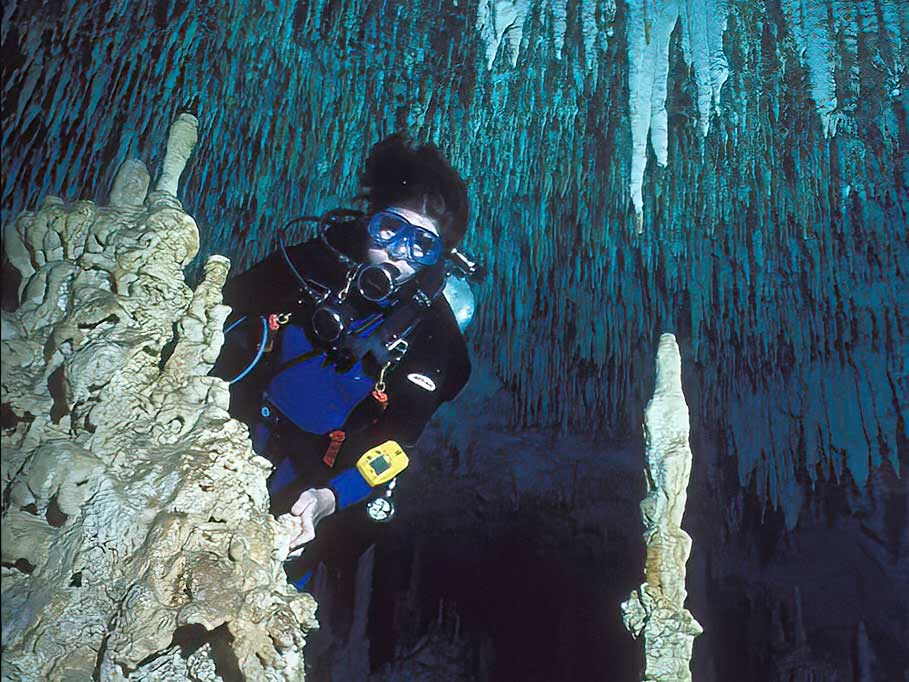From time to time, we get requests for Cavern Diver training. Unfortunately, many of the divers making these requests do not understand that Cavern Diver training differs substantially from other Specialty Diver courses. Simply stated, it is not for everyone.
In a separate article, we not only define cavern diving but also identify four ways to cavern dive safely — three of which do not involve getting a Cavern Diver card. If you’ve not already seen this article, you will want to read it as well.
In this article, we’ll help you decide whether Cavern Diver training is for you.
Knowing the difference
Cavern Diver courses and Intro-to-Tech/Tech Fundamentals courses are very similar. The chief difference is that while the Cavern Diver course addresses nearly everything covered in entry-level tech courses, it also covers diving in overhead environments. So, if you do not think you are ready for an entry-level tech course, you are not ready for Cavern Diver training.
If you read the various training agency standards for Cavern Diver courses, it may seem as though the bar is set unusually low. For example, the prerequisites for the TDI Cavern Diver course only include:
- Having logged at least 25 dives.
- Having training or experience in diving past 60 feet.
However, if you ask most experienced cave diving instructors what they feel the prerequisites should be, you will hear something very different. They will most likely want to see that you:
- Have logged at least 50 dives (with 100 or more preferred).
- Possess Nitrox and Advanced Diver certifications.
- Have absolutely exceptional buoyancy control and trim.
These aren’t absolute requirements. Nevertheless, students who meet them have a much better chance of passing the course.
That’s another thing about Cavern Diver training. While almost no one fails Underwater Photography, Underwater Navigation or similar specialty courses, ill-prepared students regularly fail to pass the Cavern Diver course.
Put another way, you don’t need to be a dive instructor to take a Cavern Diver course, but you should possess instructor-level knowledge, skills and experience.
Your goals affect your gear
Students in Cavern Diver courses can have very diverse goals.
- Some have no desire to progress beyond Cavern Diver training or explore overhead environments beyond sight of daylight. They also have no desire to do decompression diving or wear anything other than normal, single-tank dive gear.
- For others, the Cavern Diver course is just the first step in a progression leading to full Cave Diver certification. These divers often have experience in other tech diving disciplines and equipment.
How do these diverse goals affect the equipment you may use in your Cavern Diver course?
- If you tend toward the first group, you will likely take your Cavern Diver course using fairly standard recreational equipment, including a single, backmounted cylinder. Your instructor may help you dive with the least weight possible and position that weight for better horizontal trim. They will also help you eliminate any potential sources of entanglement, such as dangling octopuses and consoles. Most Cavern Diver Instructors also have their students breathe from a five- or seven-foot primary second-stage hose. This is often referred to as a recreational Cavern Diver course.
- If you are in the second group, you should do all of your overhead training in the same gear configuration you will use as a full Cave Diver. This means either backmounted doubles, sidemount or possibly even a closed-circuit rebreather (CCR). This is freaquently called a technical Cavern Diver course.
Minimize task loading
Learning to use a guideline and reel, coupled with other critical cavern-diving skills, is hugely task-loading. It is no place to add the additional distraction of unfamiliar equipment.
- If traveling by air to get to your course location, you will be forced to rent tanks and, possibly, weights when you get there. Past this, however, you should only use equipment that you personally own and can use without thinking.
- If you plan to learn in sidemount, doubles, a drysuit or CCR, you need to be totally familiar with and comfortable in their use before the start of Cavern Diver training.
To us, nothing raises alarm bells more than the person who tells us they want to take a Cavern Diver course but will need to rent everything other than mask and fins.
Remember that you have other options
If any of this sounds discouraging, remember that taking Cavern Diver training is not the only way to cavern dive safely. Your other options include:
- Don’t take a light. This prevents you from going far enough into the overhead to get into trouble. It is also a rule in effect at Florida state parks for those who lack Cavern or Cave Diver certification.
- Go with a qualified guide. In the USA, this means a fully certified Cavern or Cave Diver Instructor.
- Limit your cavern exploration to certain sites. In north-central Florida, this includes Ginnie Spring’s Ballroom, Devil’s Den, Blue Grotto and Paradise Spring. There is a broad consensus among cave diving instructors and other diving professionals that any certified diver can safely explore these caverns even if they lack Cavern Diver certification, so long as they keep the entrance clearly visible at all times.
Remember that cavern and cave diving are among the most dangerous underwater activities. Without the proper training and equipment, and a willingness to follow the rules, you can easily join the more than 350 divers who have perished in Florida caverns and caves.
The risk isn’t worth it.
Author Harry Averill is a veteran of more than 4,000 cavern and cave dives. He is a TDI Full Cave Instructor Evaluator and a past NSS-CDS Training Chairman. He is also the author of the TDI Cavern Diver manual and eLearning course.



